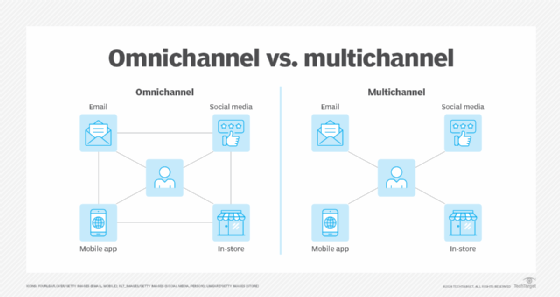
Getty Images/iStockphoto
5 benefits and examples of phygital customer experience
Modern customers expect brands to blend physical and digital channels for seamless CX -- often called phygital experiences. In turn, it helps businesses learn more about customers.
The consumer landscape has changed dramatically in recent years, thanks to a shift in behaviors and advancements in technology. Companies must adapt their marketing strategies to remain competitive and embrace phygital customer experiences.
A phygital experience gives customers the best of both the technical and physical worlds. At the same time, organizations can use various tools to prioritize customer engagement and satisfaction in person and online, which can ultimately lead to more customer loyalty and improved sales.
What is a phygital CX?
A phygital CX combines elements of physical and digital CX strategies to create a smooth and engaging customer journey. It's often used interchangeably with the phrase omnichannel experience, and is a recent trend that bridges the gap between old and new ways of consumerism.
The COVID-19 pandemic paved the way for the rise in e-commerce sales. Although many people still prefer to shop online, digital experiences lack the in-person intimacy consumers might crave. Customers want to touch and feel products, engage with store representatives and experience the social element of in-person shopping. With that in mind, organizations can create engaging phygital customer experiences.

5 benefits of embracing phygitality
Phygital CX plays an integral part in the current ecosystem of marketing strategies. Marketers might relate to certain benefits of this approach more than others.
1. More customer engagement
Marketers should evaluate every part of the customer journey, such as how customers like to shop, their values and their preferred interaction channels. From there, they can create phygital experiences using methods customers prefer. For example, organizations can send coupons through emails that customers can use in-store, including both digital and physical elements for a seamless experience.
2. Better personalized experiences and offers
Many consumers enjoy when an experience feels tailored to their interests and how they prefer to shop. Phygital CX opens doors to experiences that appeal to customers on a personal level.
Organizations can achieve this through augmented reality (AR), which uses AI to offer virtual simulations that create life-like scenarios to create tailored shopping experiences. For example, a customer might need help assembling furniture. A representative can connect with the customer through AR to walk them through the assembly process in real time. This example blends technology with physical elements to establish an optimized experience.
3. Additional customer data
Customer data fuels successful marketing strategies. Marketers can collect data in various ways, such as surveys, opt-in newsletters and social media. Phygital experiences add another layer of data collection that directly targets customers' personal interests. With data from phygital experiences, marketers get a glimpse into exactly what a consumer wants, from preferred methods of communication to customer behavior, interests and shopping trends.
4. Creating brand loyalty
Developing customer loyalty and brand loyalty keeps an organization relevant among its competitors. It requires a relatively simple formula: Create personal and unique experiences to enhance customer relationships.
Blending the physical and digital worlds appeals to modern consumers who want flexibility in how they shop. Plus, personalized experiences can create a deeper connection that businesses need with customers.
5. Boost sales
Increased customer and brand loyalty directly leads to better sales. However, repeat customers aren't the only ones influencing sales.
Even with online feedback and reviews, word-of-mouth advertising remains a powerful tool in marketing. Most people trust a friend or family member's personal experience over an online review. A single positive experience can influence the trajectory of future sales.
How to create a successful phygital CX
To create a well-rounded physical CX strategy, organizations should embrace the following tips.
- Understand customers. Learn about customers' shopping habits, their wants, preferred methods of communication, common pain points and how businesses can remediate them.
- Embrace new technologies. Consumers want to choose how they shop. Digital tools broaden the audience an organization can reach -- for example, AR tech can help create immersive experiences to boost customer engagement.
- Invest in tools for online and physical stores. Prioritize a smooth transition from the physical to the digital world and vice versa. Customers should be able to access relevant information and data from multiple channels.
- Revisit results and adjust accordingly. Routinely monitor and analyze the phygital strategy's results. As customer interests and trends change, adjust the strategy to ensure it meets customers' needs.
Real-world examples of phygital CX
Many companies have already adapted to phygital experiences. For example, restaurants, internet providers, TSA checkpoints and more businesses commonly use QR codes, which consumers can scan on their devices to open the business's website. Additionally, Nordstrom hosted more than 50 livestream shopping events amid the COVID-19 pandemic.
Other retailers developed tech-driven shopping experiences, like womenswear clothing company Reformation. Its customers can shop in-store using tablets to select clothes to try on, which are sent straight to their fitting rooms. They can also swap out clothes using an in-room tablet and get new pieces sent to them through the wardrobe's two-way closet. Similarly, Nike's Maker Studio lets customers create custom shoes using a touch-screen interface.
Phygitality enables organizations to combine their in-store and digital marketing strategies into a cohesive approach to enhance CX. Consumers inevitably align with companies that prioritize the customer journey. As a result, organizations retain loyal customers while constantly adapting to market trends to meet customer needs.
Zaida Marston is a freelance content writer with more than 10 years of creative writing experience.







